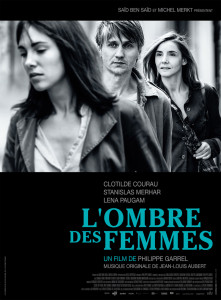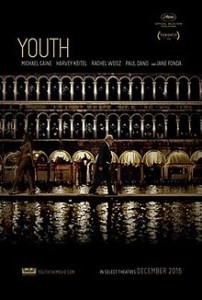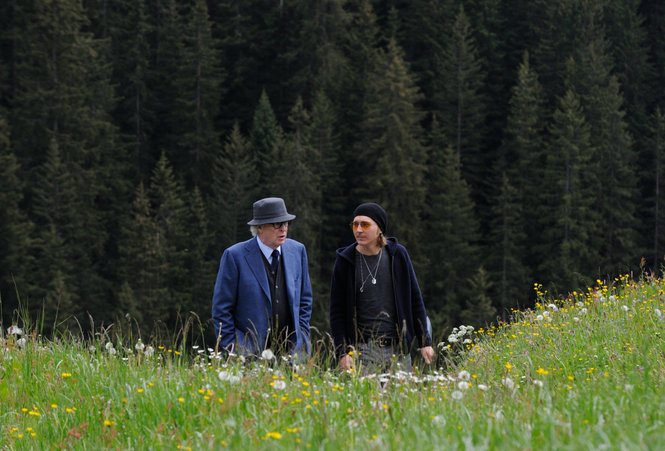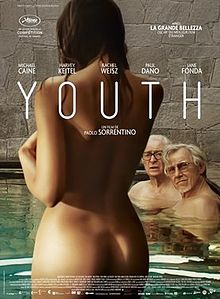Andrew Rostan was a film student before he realized that making comics was his horrible destiny, and he’s never shaken his love of cinema. Every week, he’ll opine on current pictures or important movies from the past.
I have spent more time than I could add up at the movies in Chicago, but shamefully I did not go to the Chicago International Film Festival until its 51st program this year. (And as befits our home base’s culture, it is so terrifically run I will never make the mistake of skipping it again.) My two screenings were of new films not yet generally released in America. One is a small art-house picture, the other is expected to be an Oscar contender, and both are far from perfect…yet are both worth seeing for different reasons.
In the Shadow of Women: An Unfair War
 Philippe Garrel’s L’Ombres des Femmes (In the Shadow of Women) immediately put me in mind of L’Armee des Ombres (Army of Shadows), Jean-Pierre Melville’s 1971 classic about the French Resistance. Garrel’s film includes much talk about the Resistance as the protagonists discuss the war with an aged veteran, but is about a different war: one between men and women. It is a film as gripping in its way as any war story, for Garrel and his writing partners Jean-Claude Carriere, Caroline Deruas-Garrel, and Arlette Langmann offer one of the most careful, detailed, and honest portraits of toxic masculinity I have seen.
Philippe Garrel’s L’Ombres des Femmes (In the Shadow of Women) immediately put me in mind of L’Armee des Ombres (Army of Shadows), Jean-Pierre Melville’s 1971 classic about the French Resistance. Garrel’s film includes much talk about the Resistance as the protagonists discuss the war with an aged veteran, but is about a different war: one between men and women. It is a film as gripping in its way as any war story, for Garrel and his writing partners Jean-Claude Carriere, Caroline Deruas-Garrel, and Arlette Langmann offer one of the most careful, detailed, and honest portraits of toxic masculinity I have seen.
Pierre is a rising documentarian whose wife Manon is his production assistant. The two have a devoted marriage until Pierre meets Elisabeth, the graduate student interning at Pierre’s film studio. Pierre enters into an affair with Elisabeth that, as the omniscient narrator comments, he justifies because such behavior is expected from men. A complication arises that pushes Pierre’s double standard to the limit and provokes a cycle of heartless, emotionally abusive behavior towards both women.
One of the two high points of In the Shadow of Women is most of its screenplay, which is full of truly conversational, unforced dialogue and realistic psychological portrayals of the characters that never slide into the sensational. Pierre’s laconic sense of superiority is not cartoonishly villainous, and Manon and Elisabeth are not portrayed as saints in the process of capturing our empathy as they suffer. The other high point is most of Garrel’s direction. He has been helming films since 1964, and while not as famous in America as some of his compatriots, he has the hand of a great low-key director, never wasting a shot and wrapping up the story in seventy-three minutes.
The film is marred by some poor aesthetic choices that are all the more pronounced given the short running time. There are several awkward transitions between shots, Garrel overuses the fade to black, and a score by rock star Jean-Louis Aubert is too intrusive and poorly edited until the end. The screenplay also fails by dropping Elisabeth from the film without warning and creating a subplot which should carry far more weight than it does. However, in the end this is a refreshing work from an old master which says a great deal about modern sexism and says it well, making it a recommended watch.
Youth: The Absurd Switzerland Hotel
 Paolo Sorrentino’s last film, The Great Beauty, won the 2013 Best Foreign Film Oscar and was my pick as the second-best movie of the year after 12 Years a Slave. Sorrentino found, correctly, that there was more to explore in The Great Beauty’s themes of aging and personal transformation, so with his brilliant cinematographer Luca Bigazzi in tow he created a companion piece, Youth. The first key difference between the films is that while Beauty was about one man’s odyssey in the expanse of Rome, Youth gathers an ensemble of people in the confined space of an opulent, definitely bizarre luxury resort in the Alps reminiscent of what the Grand Budapest Hotel could have been had it prospered.
Paolo Sorrentino’s last film, The Great Beauty, won the 2013 Best Foreign Film Oscar and was my pick as the second-best movie of the year after 12 Years a Slave. Sorrentino found, correctly, that there was more to explore in The Great Beauty’s themes of aging and personal transformation, so with his brilliant cinematographer Luca Bigazzi in tow he created a companion piece, Youth. The first key difference between the films is that while Beauty was about one man’s odyssey in the expanse of Rome, Youth gathers an ensemble of people in the confined space of an opulent, definitely bizarre luxury resort in the Alps reminiscent of what the Grand Budapest Hotel could have been had it prospered.
The central figure of this ensemble is resort habitué Fred Ballinger, a retired composer and conductor. In the opening scene, Fred rejects a knighthood and an invitation to conduct a last concert for the Royal Family. This serves as the catalyst for Fred to evaluate the state of his “apathetic” life through deep conversations with three people: his lifelong friend Mick, a vibrant film director working on a new screenplay with a brigade of earnest writers, his daughter and assistant Leda, who gets dumped by her husband (Mick’s son), and Jimmy, a young actor who loves making small, serious films and resents that his performance as a robot in a blockbuster has made him a star. Fred ruefully commiserates about old age with Mick, reaches emotional rapproachment with Leda, and people-watches with Jimmy, all leading to an ambiguous ending.
The ending of Youth is ambiguous because I am still not sure what Sorrentino’s point is. The final scene, I am inclined to believe, could be read as a moment of bittersweet triumph, in which the lesson age gives youth is to accept who you are and what the world around you is, face setbacks, build on your strongest points, and use those to do something great. This theme would work if the film was focused on Fred, Mick, and Jimmy, but Sorrentino divides the story and our attention enough to any reading’s detriment. He focuses on so many characters and sideplots that the audience cannot help but look for meaning in them, and unlike The Great Beauty, in which the minor parts commented on the themes, there is scant connection between the major arcs and the atmosphere, setting, and small parts—a continuing device of a rotating stage on top a swimming pool with different artists performing every night adds nothing to the picture, yet Sorrentino spends so much time with it. Also, the third act is full of surprise “gotcha” revelations that come with little to no build-up and thus seem contrived. Again, part of The Great Beauty’s excellence was how the connections between its many parts received a long, flowing build-up to a moving finish. This is missing in Youth.
Youth also does poorly by its female characters, who are portrayed as mixtures of intelligent saints and people defined by their sex appeal. Leda in the first half is a bent-not-broken figure who pulls off what could have been a troublesome “big speech” with aplomb—it helps that Rachel Weisz plays the part—but finds her feet again in the second half purely with the help of a quirky but ultra-masculine figure who reaffirms her sexuality. The other female guests over thirteen, from Miss Universe to a young masseuse with braces to a middle-aged, silent wife, are all put through various blatant stages of the male gaze. Jane Fonda, in a crucial turn as Mick’s longtime collaborator, almost comes off better than the rest in a one-scene conversation raging with guts and fire, only to have it undercut by her tiny, disastrous, and unnecessary second scene.
For all these flaws, I still recommend Youth for several good reasons. Sorrentino’s hit-and-miss screenplay is overcome by he and Bigazzi’s glorious direction and camera work. The film is a procession of beautiful, hilarious imagery, from the windswept grassy mountains against which Fred walks and talks to the dreamlike moments of Fred conducting a symphony of cows and walking on water through a flooded Piazza San Marco. The score is beautifully eclectic, ranging from Pulitzer Prize winner David Lang creating a Britten/Vaughan Williams pastiche for Fred’s music to the sounds of Sun Kill Moon and Paloma Faith.
Above all, the central three actors are great. Michael Caine, thankfully stepping away from being Christopher Nolan’s elder statesman, seemingly pours his entire life into Fred, from the spellbinding voice to the mischievous, seductive charge still present behind the sadly smiling bespectacled eyes. Caine spends enough of the film not talking that every word carries weight (a terrific scene where he talks and Weisz listens is great shorthanding of their relationship), and his wardrobe of suits and hats conveys enough reserve so that his emotional outburst resonates all the more. Caine’s two foils are equally superb. Harvey Keitel is wonderfully irascible as Mick, using outlandish humor and a guru-like demeanor to hide the uncertain fear within him, and his chemistry with Caine makes you wish they’d done more films together. Finally, Paul Dano mixes detached bemusement and soulfulness as Jimmy. It is a testament to Dano that his character has to be both symbolically proven wrong by Caine and Keitel and undergo the most ridiculous, thankless scene in the film, but his commitment to the role allows him to make Jimmy as empathetic a man. All three of them should be in the Oscar discussion.
Youth as a whole is not an awards contender: its ambitions founder, its themes grow murky, and its attitudes are sometimes troubling. However, Paolo Sorrentino is one of the masters of modern cinema and he offers a film like few you will ever see, as well as a film that different people will definitely interpret different ways. Give Youth a chance. (Then watch The Great Beauty.)
In the Shadow of Women‘s release date is pending. Youth will receive a wide release in December. Photos from Indiewire, Wikipedia, mraybould, and nola.com.






